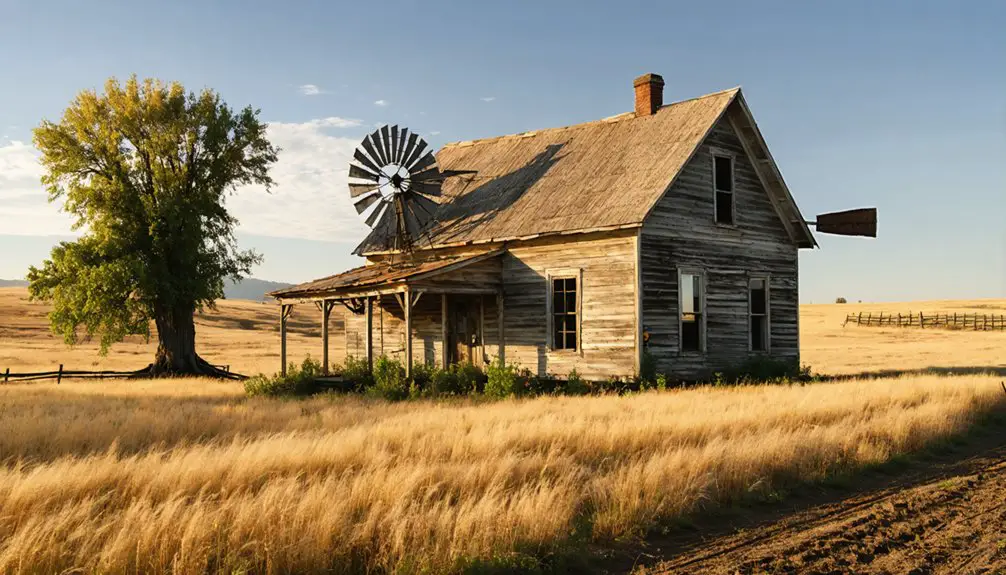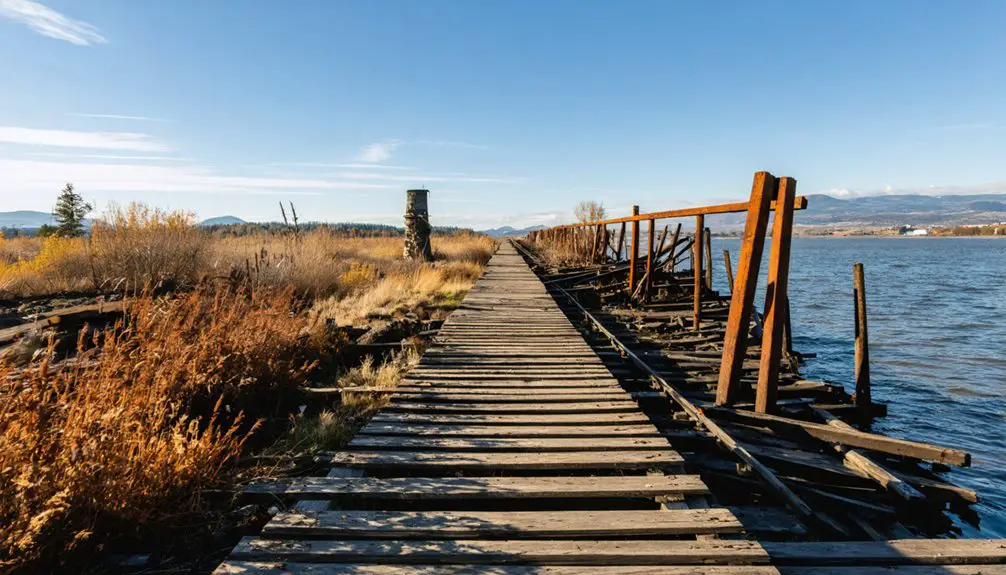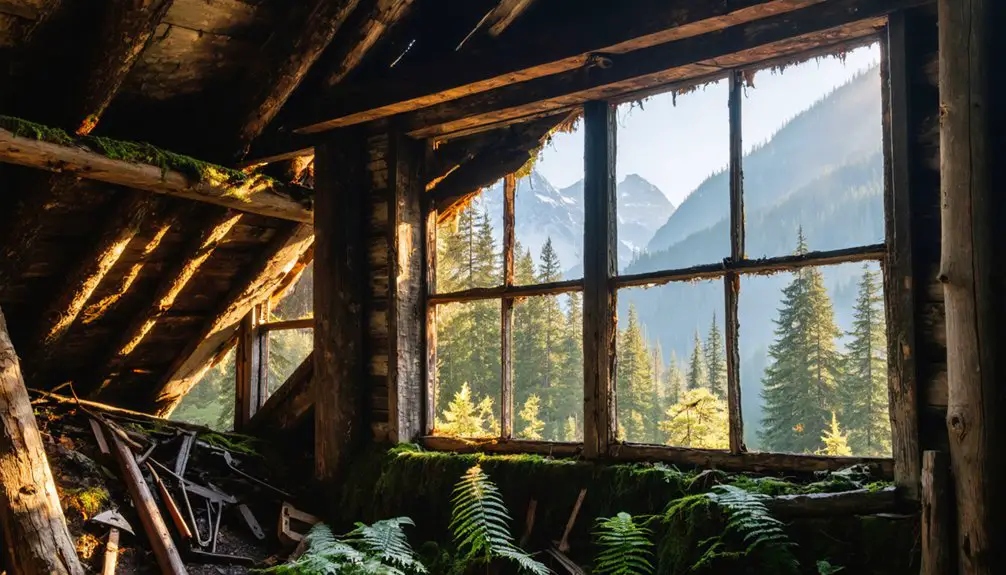You’ll find the ghost town of Elberton, Washington as just a lone church and scattered ruins today, but in 1900 it was a thriving community of 500 residents. Founded in 1886 by Sylvester M. Wait, the town boasted the world’s largest prune dryer, sawmills, and flour mills along the Oregon Railway line. Natural disasters struck in 1908-1910, with a devastating fire and floods marking the beginning of its decline. The untold stories of Elberton’s rise and fall await in its weathered foundations.
Key Takeaways
- Elberton is a ghost town in Washington state, founded in 1886, that reached its peak population of 500 residents around 1900.
- The town prospered through sawmills, flour mills, and the world’s largest prune dryer before declining due to natural disasters and economic setbacks.
- A devastating fire in 1908 and severe flooding in 1910, combined with the railway closure in 1907, accelerated the town’s abandonment.
- The historic United Brethren Church, built in 1913, stands as the only intact building among scattered foundations and ruins.
- The abandoned railroad trestle and building remnants attract ghost town tourists interested in exploring this once-thriving community’s remains.
The Birth of a Frontier Town (1886)
As frontier settlements dotted the Palouse region of Washington Territory in the late 19th century, Sylvester M. Wait established a crucial outpost that would become Elberton.
The founding importance of this 1886 settlement centered on its prime location near the Palouse River, surrounded by timber-rich hills and fertile agricultural land. The area had already proven its worth with a water-powered sawmill operating since the 1870s.
The naming origins trace back to Wait’s personal tragedy – he christened the town in memory of his son Elbert, who’d died the previous year at age twenty-five.
Working alongside county commissioner C.D. Wilbur, Wait quickly developed the settlement’s infrastructure. The town’s earliest resident was C.D. Wilbur himself, who had settled in the area during the 1870s.
With Wilbur’s backing as commissioner, Wait efficiently established the vital framework needed for Elberton’s growth and development.
You’ll find the town’s strategic placement along the Oregon Railway & Navigation Company line particularly significant, as it guaranteed essential transportation access.
Wait wasted no time launching a steam-powered sawmill, setting the stage for Elberton’s early economic foundation.
Early Growth and Development
While Sylvester Wait’s sawmill anchored Elberton’s initial growth in 1886, the town’s rapid expansion over the next two years brought an impressive array of businesses and services.
The town soon included a post office and established itself as an important regional hub.
You’d have found flour mills, grain warehouses, general stores, and multiple blacksmith shops serving the bustling community‘s needs.
The area’s agricultural success led to the establishment of what became the world’s largest prune dryer during Elberton’s peak years.
Economic Prosperity at the Turn of the Century
As you explore Elberton’s peak economic years around 1900, you’ll find a bustling town of 500 residents supported by thriving fruit orchards and W.K. Allen’s massive fruit drier processing 1,800 bushels daily.
The town’s sawmills near the Palouse River and multiple flour mills formed the industrial backbone, while the Oregon Railway & Navigation Co. rail line enabled efficient transport of timber and agricultural products to broader markets. Like the later development of Elberton, Georgia, this town’s growth was heavily influenced by the arrival of northern entrepreneurs seeking new business opportunities. The town’s success was cut short when a devastating fire in 1908 marked the beginning of its decline.
Local commerce flourished with multiple general stores, blacksmith shops, wagon shops, and other establishments serving the growing community’s needs.
Booming Business and Trade
During the late 1890s and early 1900s, Elberton transformed into a bustling commercial hub with nearly 500 residents.
You’d find a vibrant mix of businesses driving the local economy, including flour and sawmills, multiple general stores, and specialized shops serving both townspeople and rural communities.
The town’s trade networks expanded greatly with the arrival of rail service, connecting Elberton to markets 58 miles away in Spokane.
Two livery stables, blacksmith shops, and a wagon shop kept goods and people moving, while economic drivers like the massive fruit drier processed up to 1,800 bushels daily.
The famous Elberton Picnic drew prominent figures like William Jennings Bryan, showcasing the town’s prosperity through grain warehouses, hotels, and a thriving service industry.
The area’s extensive prune orchards contributed significantly to the local agricultural economy.
Today, the once-prosperous town has dwindled to just a few dozen residents, marking a dramatic decline from its heyday.
Agricultural and Timber Success
The twin pillars of agriculture and timber supported Elberton’s economic success at the turn of the century.
You’d have found W.K. Allen’s fruit drying facility processing an impressive 1,800 bushels daily, making it the world’s largest operation of its kind.
While prune orchards flourished in the fertile Palouse soil, the local sawmill kept buzzing until 1906, when timber depletion forced its relocation to Idaho.
- Towering fruit trees stretching across vast orchards
- Steam rising from the massive fruit drying facility
- Sawmill workers hauling fresh-cut timber through town
- Wagons loaded with prunes headed to market
Daily Life in Peak Elberton
If you’d visited Elberton during its 1900 peak, you’d have found a bustling business district with two general stores, a drug store, hardware store, and two blacksmith shops serving the town’s 400 residents.
At the heart of daily commerce, farmers brought their prunes to one of the world’s largest fruit dryers, capable of processing 1,800 bushels daily, while townspeople gathered at the hotel and bar or shopped at the local meat market.
The United Brethren Church, built in 1913, anchored the community’s social life, complementing the practical amenities of the post office, livery stables, and wagon shop that supported Elberton’s agricultural way of life. Today, only non-native trees and depressions in the ground hint at where these buildings once stood.
Town Services and Amenities
While Elberton’s population never exceeded 500 residents, the town boasted an extensive range of services and amenities by the early 1900s.
You’d find essential town amenities like the post office handling mail routes to Spokane, while three churches, including the United Brethren Church, served as spiritual and social centers. Community services extended from education to commerce, creating a self-sufficient small town. The town’s famous three-day fair attracted hundreds of visitors and notable figures to the community each year.
- You could get your daily necessities at two general merchandise stores or visit the local drug store for medical supplies.
- Your transportation needs were met by two blacksmith shops and a wagon shop.
- You’d find fresh food at the meat market or get your grain processed at the flour mill.
- When traveling, you could stay at the local hotel or grab a drink at the bar.
Business District Activities
During Elberton’s bustling peak years, you’d find a vibrant business district humming with daily commerce and trade activities.
The town’s trading hubs included two general stores, a drug store, and multiple hardware shops where you could get your essential supplies. You’d see farmers bringing their grain to the warehouses and fruit to W.K. Allen’s massive fruit drier, which processed up to 1,800 bushels daily by the 1890s.
For transportation needs, you could visit two livery stables or get your wagon repaired at the local wagon shop. The blacksmiths kept both farming equipment and horse-drawn vehicles running smoothly, while meat markets and the flouring mill guaranteed you’d never go hungry.
The railroad connected you to broader markets, especially Spokane, 58 miles away.
Community Social Life
As Elberton reached its peak population of 500 residents, you’d find a rich tapestry of social life woven around three churches, various businesses, and seasonal agricultural rhythms.
The United Brethren Church stood as the heart of religious significance, hosting both services and community gatherings.
You’d spend your days moving between social hubs like the post office, general stores, and hotel, where news and conversation flowed freely.
- Join your neighbors at church functions, where hymns and fellowship strengthen community bonds
- Trade stories at the local hotel after a day’s work in the prune orchards
- Gather at the blacksmith shop while waiting for repairs, sharing local happenings
- Celebrate seasonal harvests and holidays with townwide festivities, reinforcing your rural traditions
Natural Disasters and Economic Setbacks
Once a thriving timber and agricultural hub, Elberton faced devastating blows in the early 1900s that sparked its eventual decline.
In 1908, a major fire ravaged the town’s businesses and homes, severely undermining its economic resilience. Before disaster recovery could take hold, the community was hit by severe flooding in 1910, dealing another crushing blow to rebuilding efforts.
These natural disasters coincided with the closure of the Oregon Railway & Navigation Co. line in 1907, effectively cutting off essential trade routes. The town’s backbone industries – timber and flour milling – couldn’t survive these setbacks.
The sawmill shuttered as local timber depleted, while the world’s largest fruit dryer, capable of processing 1,800 bushels daily, eventually ceased operations.
The Long Road to Abandonment
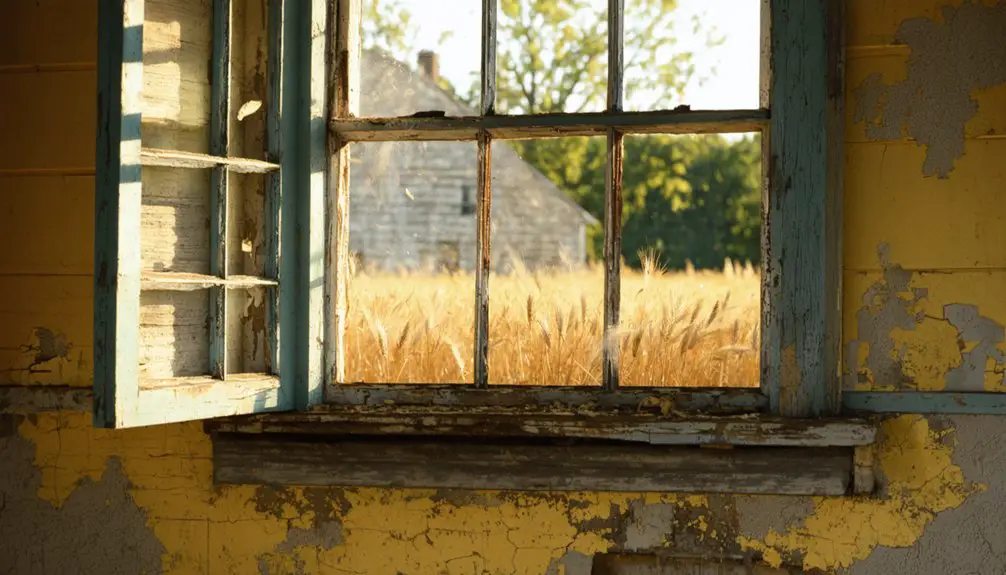
The compounding effects of natural disasters and economic setbacks set Elberton on an irreversible path toward abandonment.
Poor resource management led to the depletion of timber stocks, forcing the sawmill’s relocation to Idaho. Without this economic anchor, you’d have witnessed the town’s steady unraveling through the early 1900s.
The town’s lifeline – its sawmill – vanished with the last timber, leaving Elberton to wither on the economic vine.
- Empty storefronts where thriving businesses once served 400 residents
- Abandoned fruit orchards that previously processed 1,800 bushels daily
- Crumbling infrastructure from the 1908 fire and 1910 flood damage
- Deteriorating railroad trestles that once connected the town to prosperity
The Great Depression delivered the final blow, accelerating population decline as families sought opportunities elsewhere.
Surviving Structures and Remnants
Modern visitors to Elberton will find sparse physical reminders of this once-bustling town, with the 1913 United Brethren Church standing as its sole intact building.
Though boarded up, the church’s architectural significance remains preserved on the main road, serving as an indication of the community’s past importance.
Behind the church, you’ll discover the abandoned railroad trestle spanning the Palouse River – its engineering still visible despite warning signs.
As you explore, you’ll notice the scattered foundations of former homes and businesses, now overtaken by grass and non-native trees.
The historical preservation of these remnants, along with an overgrown cemetery and a few decaying homes, provides glimpses into Elberton’s agricultural and timber heritage.
These silent structures tell the story of a once-thriving settlement.
Modern-Day Ghost Town Legacy
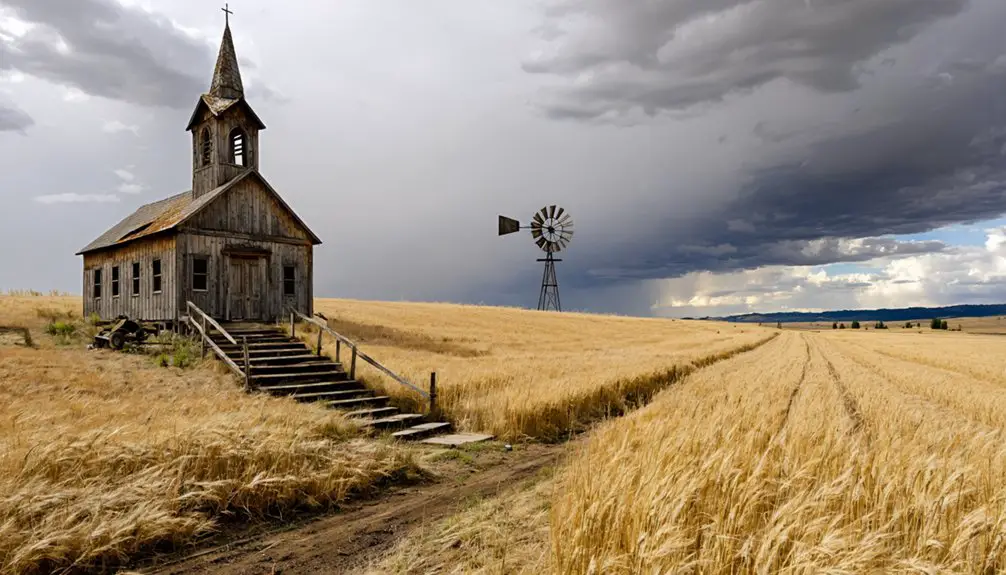
While physical remnants tell part of Elberton’s story, its legacy as a ghost town speaks volumes about Washington State’s evolving rural landscape.
Today, you’ll find a scattered community of fewer than 20 residents living near what was once a bustling town of 400. Ghost town tourism draws history enthusiasts to explore these haunting grounds, where nature slowly reclaims man-made structures.
Where 400 souls once built their dreams, only 20 remain to watch time and wilderness slowly erase humanity’s footprints.
- You can walk among stone foundations where general stores and blacksmith shops once thrived
- You’ll discover the historic United Brethren Church standing as a silent sentinel to the past
- You can trace the old railroad line where commerce once flowed through the community
- You’ll find historical preservation efforts primarily driven by grassroots initiatives rather than formal programs
The town’s story endures as a reflection of the fragility of resource-dependent communities.
Frequently Asked Questions
Are There Any Reported Ghost Sightings or Paranormal Activity in Elberton?
Despite Elberton’s 400-person peak population in 1900, you won’t find documented ghost encounters or spectral legends here. The abandoned church and cemetery create an eerie atmosphere, but there’s no verified paranormal activity.
Can Visitors Legally Explore the Remaining Structures in Elberton Today?
You’ll need local permission since legal access is unclear. While some county-owned areas allow managed activities, most structures lack official exploration guidelines. Exercise caution and verify current regulations before visiting.
What Happened to the Original Town Records After Disincorporation?
Left scattered, lost, and forgotten, the original records likely went to Whitman County offices after the 1966 disincorporation. You’ll find no clear documentation of their exact fate today.
Did Any Famous or Notable People Ever Live in Elberton?
You won’t find any famous residents in Elberton’s history, despite notable events like W.K. Allen’s record-breaking fruit drying operation. The town’s pioneers were hardworking settlers rather than celebrated figures.
Were There Any Significant Native American Settlements in the Area Before Elberton?
While Native tribes like the Palouse lived throughout eastern Washington for thousands of years, you won’t find specific records of settlements at Elberton’s exact location, though they likely used the area’s rivers and forests.
References
- https://theclio.com/entry/49583
- https://www.inlander.com/culture/elberton-wash-this-picturesque-palouse-town-thrived-from-agriculture-and-timber-but-died-out-as-nearby-resources-did-28851239
- https://www.atlasobscura.com/places/elberton-ghost-town
- https://mwhomestead.blogspot.com/2018/08/elberton.html
- https://www.youtube.com/watch?v=k7xM3GoNz2E
- https://www.wcgazette.com/story/2024/10/10/people/the-haunting-hour-spirits-stranded-in-a-ghost-town/42266.html
- https://www.instagram.com/ghost.wa/p/DGrRJqQg_3q/?locale=ko-KR
- http://pearailroad.blogspot.com/2016/07/history-snapshot-elberton.html
- https://www.instagram.com/p/DGrRJqQg_3q/?locale=id&hl=en
- https://www.georgiaencyclopedia.org/articles/counties-cities-neighborhoods/elberton/
